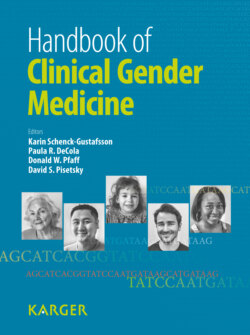Читать книгу Handbook of Clinical Gender Medicine - Группа авторов - Страница 109
Pathogenesis The Extreme Male Brain Theory of Autism Spectrum Conditions
ОглавлениеThe term ‘extreme male brain’ was first applied to autism anecdotally by Hans Asperger in 1944; he wrote that ‘the autistic personality is an extreme variant of the male intelligence’ [translation from p. 84 in 5]. Recently, this theory has been systematically reexamined as an explanation of cognition and neuroanatomy in individuals with ASC. In order to understand ASC as an extreme male brain, it is necessary to understand ASC as an extreme of typical development in general. Most people have approached ASC research with a medical model that assumes a categorical distinction between ASC and ‘normality’. Such a model implies a bimodal distribution and focuses research on finding one or more mutations that produce the ‘disorder’.
It is increasingly suggested that ASC is a spectrum of conditions that blends into the whole of the population. In other words, ASC occurs in the tails of a normal distribution. This model is multifactorial and will include polygenic effects and environmental influences, one of which may be testosterone (for reasons to be discussed). It is also important to understand that, in terms of cognition and brain structure, ‘male’ and ‘female’ are not distinct categories; they too are dimensional. Within each sex, there is individual variability, and there is a substantial overlap between male and female distributions.
Regarding cognition, individuals with ASC tend to display an exaggerated male profile. For example, on the Embedded Figures Test (EFT) and on tests of intuitive physics, both males and females with ASC perform better than typical males, who perform better than typical females [6– 8]. On tests involving complex language and ‘intuitive psychology’, they perform worse than typical males, who perform worse than typical females. A similar pattern is seen on questionnaires designed to assess the extent to which an individual shows autistic traits, including the Autism Spectrum Quotient (AQ; adult, adolescent, and child versions), the Childhood Autism Screening Test (CAST), the Quantitative Checklist for Autism in Toddlers (Q-CHAT), and the Social Responsivity Questionnaire (SRS) [see 4 for review].
Analogies can also be drawn between sex differences in brain development and neuroanatomical characteristics found in ASC. Although there is a great deal of individual variation in human brain morphometry, the cerebrum as a whole is about 9% larger in men and in boys. One of the most consistent anatomical findings in children with ASC is that young children with autism tend to have larger-than-average heads. Magnetic resonance imaging confirms that these large heads contain abnormally large brains. Reports of regional differences in sexual dimorphism are more controversial, but correcting for the overall larger size of male brains, the amygdala is disproportionately large in boys while the hippocampus and caudate are disproportionately large in girls. Like an exaggeration of typical boys, children with ASC show greater growth of the amygdala [see 4 for review].
Finally, studies of brain function also reveal similarities between typical sex differences and differences between those with ASC and neurotypicals. The ‘default mode network’ (DMN) is decreased in functional connectivity in males relative to females during resting conditions. In ASC, connectivity within the DMN is even more decreased during rest. Using task-related functional MRI, typical males show decreased activity in the posterior parietal cortex (BA 7) during the EFT and people with ASC show even less activity in BA 7 during this task. Finally, typical males show decreased activity bilaterally in the inferior frontal gyrus (BA 44/45) during the ‘Reading the Mind in the Eyes’ Test relative to typical females, and people with ASC show even less activity in this region during this task [see 4 for review].
So, which biological mechanisms shape the sex differences described above and is there evidence that these mechanisms are disrupted in individuals with ASC? In the following sections we review evidence for the role of prenatal androgens and sex chromosome effects.
